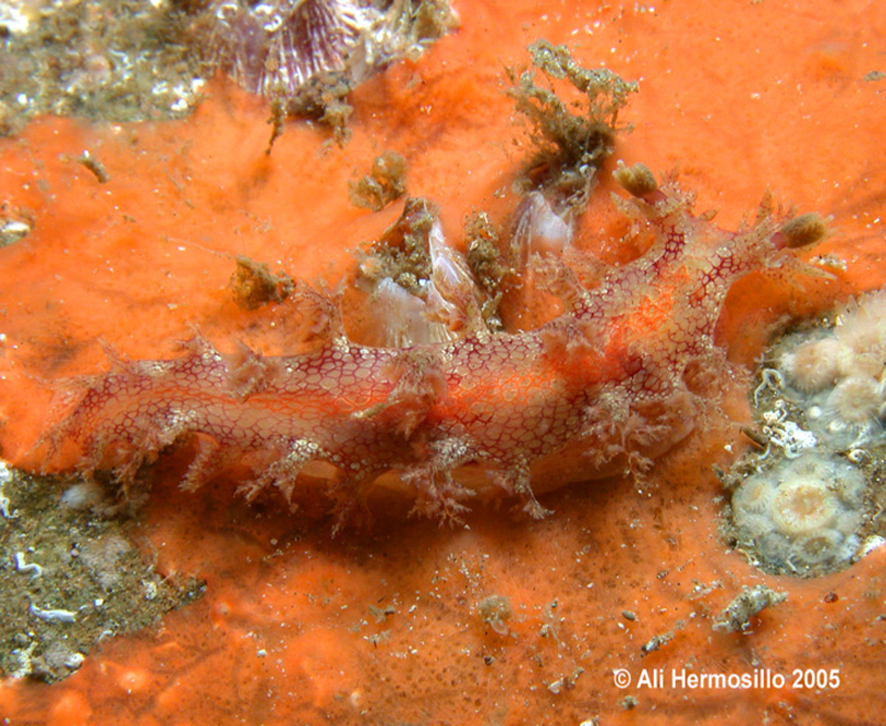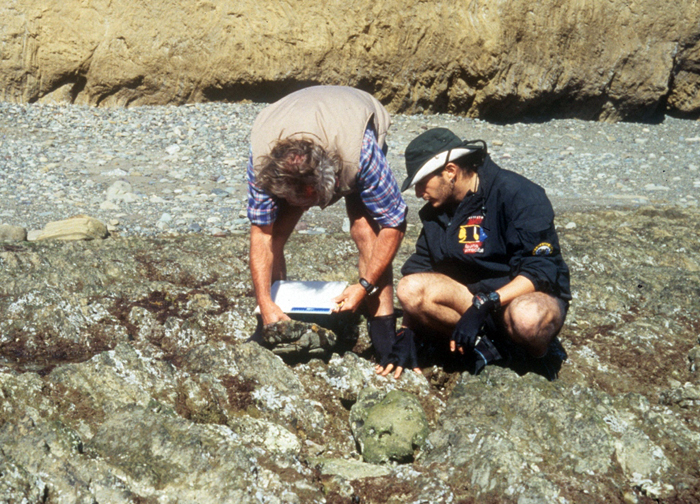 |
Marionia kinoi
(Photo by Alicia Hermosillo, from (BOW Week 481)
Puerto Vallarta, Jalisco, México
Marionia kinoi Angulo-Campillo & Bertsch, 2013
Since 2005, this distinctive species has been reported as unnamed from the Mexican Pacific (Puerto Vallarta, Jalisco), Costa Rica, Panamá and the Islas Galápagos (Behrens & Hermosillo, 2005, and Camacho-García, Gosliner & Valdés, 2005). The recent collection of several specimens from two miles south of Las Arenas (on the Gulf of California coastline east of La Paz, Baja California Sur), provided us with the opportunity to name this species.
Notable externally is the bright orange coloration of this species. The animal is light orange to brownish red, with small light colored tubercles spread net-like over the dorsum surface. The sheaths and shafts of the rhinophores are orange. There are 11 relatively short branchial plumes per side. The gonopore is located on the right side, at the first third of the body, below and between the 2nd and 3rd branchial plume. The anus is situated below the 3rd branchial plume at the same height as the gonopore. These are well illustrated in Orso’s drawing of the animal.
The masticatory margin of the jaws exhibit three to four rows of conical rodlets. The radula of the paratype is large, with a formula of 45 (35.1.1.1.35); the scanning electron micrograph was taken at the widest part of the radula. The rachidian tooth is tricuspid, with a base roughly triangular, and resembles the shape of an “M.” The central cusp is thick, asymmetrical, incised in the shape of a “V,” with a profound canal that begins at the base and fades to the right side of the cusp.
Tritoniids are known to have a feeding specificity on a single species or small group within a family of Octocorallia (Smith & Gosliner, 2003). For instance, Marionia hawaiiensis (Pease, 1860) feeds upon Anthelia (see illustration in Bertsch & Johnson, 1981), and M. bathycarolinensis Smith & Gosliner, 2003, is a specific predator on Paracis. Marionia kinoi has been reported to feed on species of the octocoral genus Carijoa (Camacho-Garcia et al., 2005). The species Tritonia papalotla Bertsch, Valdés & Gosliner, 2009, feeds on zoanthid anemones of the genus Epizoanthus; recent genetic work by Jermaine Mahguib (pers. comm. 2013) confirms my 30-year-old belief it is an unnamed genus; it might possibly even belong to a new family.
The specific name kinoi was given in honor of Padre Eusebio Francisco Kino, S.J. (1645-1711), the first Pacific conchologist (Baily, 1935), and intrepid explorer and cartographer of the Californias. His knowledge of the distribution of abalones was crucial for his determination that Lower California was a peninsula, not an island (Bertsch, 2010 and 2011).
References
Angulo-Campillo, Orso, and Hans Bertsch. 2013. Marionia kinoi (Nudibranchia: Tritoniidae): A new species from the tropical eastern Pacific. The Nautilus 127 (2): 85-89.
Baily, Joshua L. 1935. The first Pacific conchologist. The Nautilus 48: 73-75.
Behrens, David W., and Alicia Hermosillo. 2005. Eastern Pacific Nudibranchs: A Guide to the Opisthobranchs from Alaska to Central America. Sea Challengers, Monterey, CA. vi + 137 pp.
Bertsch, Hans. 2010. Las conchas azules (the blue shells): Father Kino, abalones, and the island of California. The Nautilus 124 (4): 188-191.
Bertsch, Hans. 2011. The missionary explorer-scientist, Father Eusebio Kino, S.J.: Faith, maps, sea shells and Mission San Xavier del Bac. Catholic Southwest, A Journal of History and Culture 22: 65-85.
Bertsch, Hans, and Scott Johnson. 1981. Hawaiian Nudibranchs. Oriental Publ. Co., Honolulu. 112 pp.
Bertsch, Hans, Ángel Valdés & Terrence M. Gosliner. 2009. A new species of tritoniid nudibranch, the first found feeding on a zoanthid anthozoan, with a preliminary phylogeny of the Tritoniidae. Proceedings of the California Academy of Sciences 60: 431-446.
Camacho-Garcia, Yolanda, Terrence M. Gosliner & Ángel Valdés. 2005. Guía de Campo de las Babosas Marinas del Pacífico Este Tropical. California Academy of Sciences, San Francisco. 129 pp.
Smith, V. G., and Terrence M. Gosliner. 2003. A new species of Tritonia from Okinawa (Mollusca: Nudibranchia), and its association with a gorgonian octocoral. Proceedings of the California Academy of Sciences 54: 255-278.
Hans Bertsch and Orso Angulo-Campillo
Send Hans email at: hansmarvida@sbcglobal.net
Send Orso email at: korak12@hotmail.com
Hans and Orso doing intertidal work at Bahía Tortugas
 |
|
